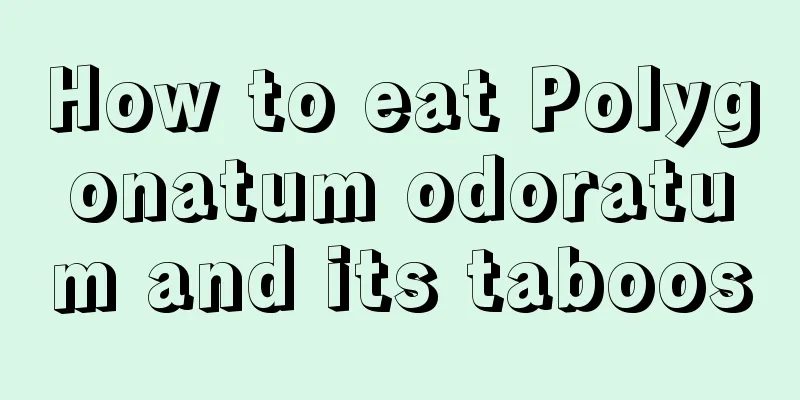How to eat Polygonatum odoratum and its taboos

The therapeutic value of Polygonatum odoratumFrom the perspective of traditional Chinese medicine, Polygonatum odoratum has the effects of nourishing yin and moistening dryness, relieving restlessness and quenching thirst. It is a top-grade material for Chinese medicine food supplements, suitable for people of all ages, and its effect is comparable to astragalus and ginseng. Polygonatum odoratum contains a large amount of amino acids and nutrients such as zinc, manganese, etc., which can protect the cardiovascular system, clear out waste in the body and delay aging. It is said that Zhao Feiyan, the empress of Emperor Cheng of Han during the Western Han Dynasty, maintained her graceful figure and body as light as a swallow because she often ate Polygonatum odoratum. How to eat Polygonatum odoratumThere are two main ways to eat Polygonatum odoratum: making tea and making soup. Polygonatum odoratum teaPolygonatum odoratum tea is very helpful for patients with diseases such as hypertension, angina pectoris, chloasma, etc. It also has a good effect on weakness after illness and long-term cough in the elderly. In ancient China and ancient Goryeo, there was a custom of boiling water with Polygonatum odoratum for drinking, which had the effect of strengthening the body. Polygonatum odoratum soupMany people in Guangdong use Polygonatum odoratum as an ingredient for making soup. It is also one of the folk ingredients for promoting lactation. Autumn is the best season to eat Polygonatum odoratum. The very famous "Qingbuliang" soup is made by mixing Polygonatum odoratum, Adenophora radix, Chinese yam, longan, lotus seeds, lily and coix seed. It is very suitable for consumption in the dry autumn season. What are the edible taboos of Polygonatum odoratumThe following groups of people should not eat Polygonatum: People with spleen deficiency, loose stools, and internal phlegm and dampness should not eat Polygonatum. People with diarrhea (cold nature), bloating, dislike of drinking water, and excessive phlegm are also not suitable for eating Polygonatum. Any medication and diet therapy must be taken/consumed under the advice of a doctor. I wish you all good health! |
<<: The efficacy and function of nail orchid
Recommend
It is best to water Milan flowers every few days
How often should I water Milan flowers? Milan flo...
What is the best season to plant Chinese cabbage?
Which month is suitable for planting Chinese cabb...
How to water Endless Summer
Watering time Water is one of the essential facto...
Saffron introduction, what is saffron
1. Family Saffron, also known as crocus, is a per...
What fertilizer is best for onion seedlings
Fertilizing time for onion seedlings Onion seedli...
What should I do if the pearl plant rots? Do this to save your flowers!
Causes and solutions for the rot of pearl spider ...
The main varieties of four-orange
The main varieties of four-orange There are three...
Cabbage planting method steps Cabbage planting technology and management points
Cabbage cultivation is generally based on autumn ...
Wheat planting time and method
Wheat planting time The best time to plant wheat ...
Characteristics of Pear Trees
1. Appearance characteristics 1. The leaves of th...
What to do if the new leaves of gardenia turn yellow
1. Increase fertilization 1. Reason: If you ferti...
When is the best time to divide jasmine into pots?
Time to divide jasmine into pots The best time to...
What to do if the leaves of green radish are frozen to death
1. Treatment methods When you find that the leave...
Mulberry leaf peony cutting propagation method and precautions
How to propagate peony Mulberry leaf peony is hib...
Can lucky bamboo be watered with beer water?
Can lucky bamboo be watered with beer water? Luck...









